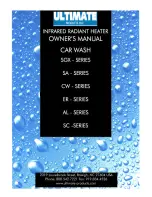
4
EN
4. Occurrence of water: intermittent condensation of water or occurrence
of water vapor
5. Occurrence of foreign bodies: quantity and type of dust are insignificant
6. Protection degree: min. IP20 (device protected from touching
dangerous parts by hand and non-waterproof)
• This degree of protection is not indicated on the product and on the
technical parameters in the operating instructions.
• If the protection class of the product is different from IPX0, this
information is then displayed on the label of the appliance or in the
technical data of the operating instructions.
• Other characteristics of the domestic operating environment
(mechanical stress - strain and vibrations, occurrence of plant, animals,
weather effects ...) are negligible in terms of effect on the correct and
safe use of electrical equipment.
1.3 Electrical safety
• Before connecting the appliance to the power supply for the first time,
make sure that the voltage on the appliance label corresponds to that of
the household electrical socked.
• The electric appliance is designed to power from 1/N/PE ~ 230 V 50 Hz.
• The electrical safety of the appliance is guaranteed only if it is properly
connected to the mains.
• Electrical protection class I equipment is equipped with a protection
against electric shock by means of protective earthing of inanimate
parts, which can become dangerous when the device is malfunctioning.
Always connect such devices to properly installed mains sockets that
are equipped with earthing conductors and have a properly grounded
earthing conductor.
All electrical equipment is equipped with a three-wire power supply.
• Class II electrical equipment is protected against electric shock by
double insulation or by enhanced insulation of hazardous live electrical
parts. Device of protection class II it must not be equipped with means
to connect protective earthing.
All electrical equipment is equipped with two-wire power supply.
• Class III electrical equipment is a device that is powered by a small
safe voltage source (battery or accumulator) and does not present any
danger to the user from electrical shock.
• In order to provide increased safety against the risk of electric
shock due to the use of electrical appliances by laypersons, it is
recommended to install the power supply circuit for sockets with a rated
current not exceeding 20 A RCD with a rated operating current not
exceeding 30 mA.
To ensure the safety and correctness of the electrical installation,
consult with a qualified electrician.
• Only use a power cord with a plug (mains lead) supplied with the device
and compatible with a wall socket. Using another cable may result in
fire or electric shock.
• Always connect an electrical appliance to an easily accessible mains
socket. In the event of an operating fault, the appliance must be





































